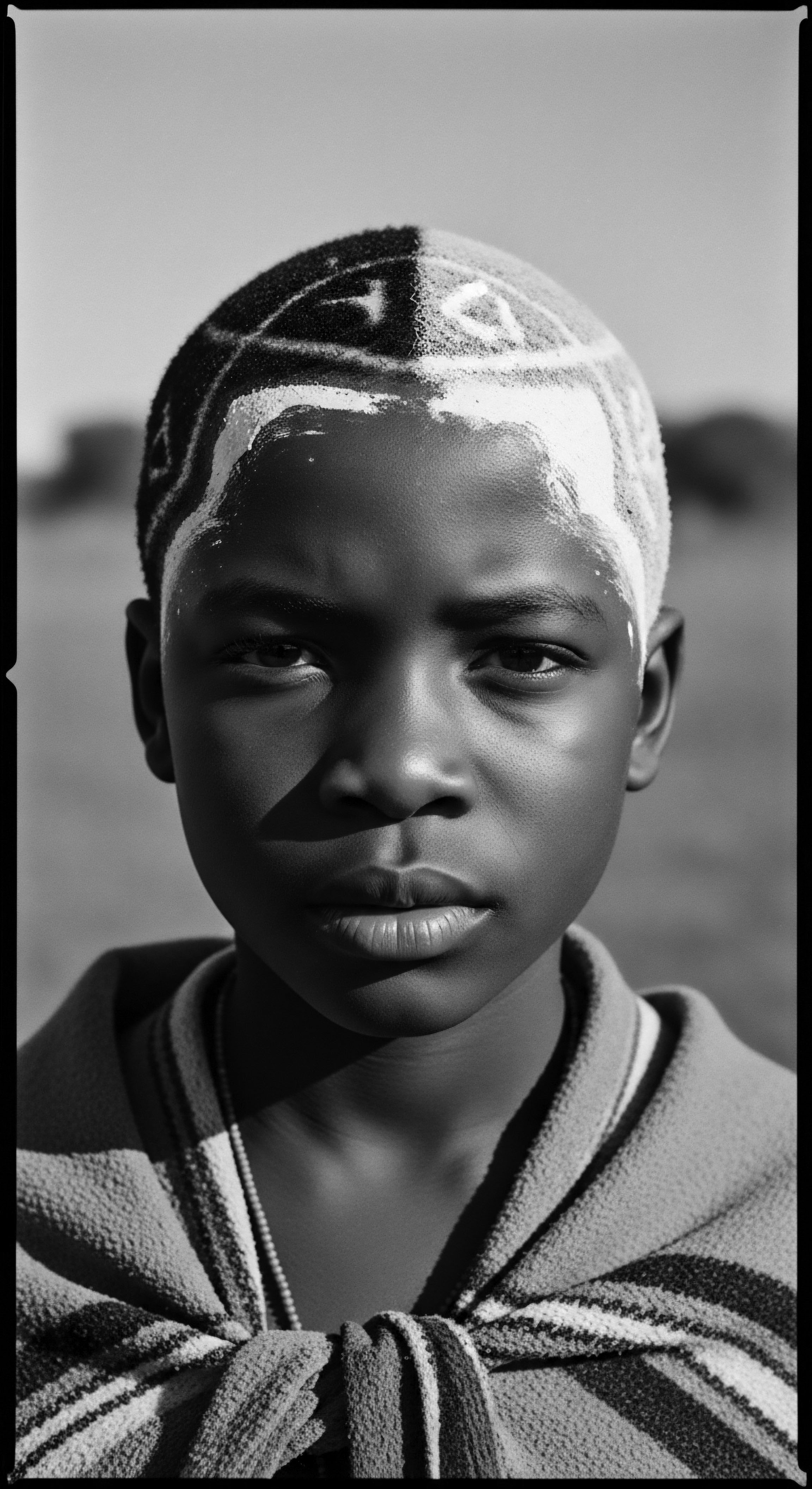The journey into the profound understanding of Karkar Oil commences within the sacred archives of Roothea’s living library, a repository where each strand tells a story of enduring heritage. This is not merely a botanical exploration; it is a spiritual homecoming, a recognition of the wisdom passed through generations. We seek to unravel the meaning of Karkar Oil, not as a fleeting trend, but as a deep cultural statement, a testament to the resilience and artistry embedded within textured hair traditions. Our approach blends the meticulous observation of a cultural historian, the compassionate guidance of a wellness advocate, and the clarity of a scientist, all unified by an unwavering reverence for ancestral knowledge.

Fundamentals
Karkar Oil, in its simplest designation, represents a traditional unguent, a meticulously crafted blend deeply rooted in the hair care practices of communities across Sudan and Chad. Its very name, derived from the Arabic root for the rhythmic, repetitive motions of stirring, speaks to the careful, hands-on preparation that has characterized its existence for centuries. This ancestral formulation is more than a mere topical application; it stands as a cornerstone of traditional beauty rituals, particularly for those with textured hair. Its original significance, as understood by early communities, rested in its ability to confer resilience and vitality upon hair strands, guarding against the harsh environmental conditions of the Sahel region.
The core ingredients of Karkar Oil traditionally include Sesame Oil, Animal Fat (often from sheep or ostrich), Honey Wax, and various aromatic elements like mahlab, cloves, or sandalwood powder. This precise combination reflects a deep, intuitive understanding of natural properties long before modern scientific classification. Sesame oil, often the primary base, provides a nourishing foundation, while the animal fat contributes a rich, occlusive layer, sealing in moisture. Honey wax, a natural humectant, draws hydration into the hair, creating a protective barrier.
The inclusion of fragrant botanicals not only imbued the oil with a pleasant aroma but also often carried their own traditional benefits for scalp health. This comprehensive approach to hair care was not about quick fixes; it was about sustained, respectful cultivation of hair health, reflecting a holistic perspective on well-being that linked external beauty to internal harmony and ancestral connection.
Karkar Oil embodies a profound legacy of ancestral care, a blend of natural elements meticulously prepared to nourish and protect textured hair, speaking volumes of cultural wisdom.
Understanding the meaning of Karkar Oil begins with appreciating its foundational role in daily life and communal bonding. Hair care in these societies was not an isolated act of self-grooming; it was a communal ritual, a shared experience that strengthened social ties and transmitted knowledge across generations. Mothers taught daughters, and grandmothers guided their kin in the intricate process of preparing the oil, applying it, and braiding hair, ensuring the continuity of these vital practices. The presence of Karkar Oil in these settings signifies a collective commitment to preserving heritage, celebrating identity, and maintaining the physical manifestation of lineage through hair.

Origins in Sahelian Traditions
The geographical heartland of Karkar Oil’s historical use lies within the vast expanse of Chad and Sudan, regions where indigenous populations developed sophisticated methods for thriving in challenging climates. The women of the Basara Arab tribes in Chad, renowned for their exceptionally long hair, often reaching remarkable lengths, have long utilized Karkar Oil in conjunction with other traditional powders like Chebe. This practice is documented to have persisted for centuries, serving as a testament to its efficacy and cultural embedding.
The knowledge associated with Karkar Oil’s preparation and application is a living archive, preserved through oral traditions and hands-on teaching within families and communities. This deep historical root establishes Karkar Oil as a symbol of endurance and a practical tool for hair preservation in arid environments.
The historical delineation of Karkar Oil’s use points to its role in maintaining hair length and preventing breakage, which are significant challenges for textured hair types in dry conditions. The combination of fatty ingredients created a formidable barrier against moisture loss, a practical application of environmental adaptation that predates modern cosmetic science. This deep-seated practice reflects a profound connection to the land and its resources, where local flora and fauna provided the sustenance for both body and beauty.
- Sesame Oil ❉ A primary carrier, valued for its moisturizing and emollient properties, providing a base for the blend.
- Animal Fat ❉ Often derived from sheep, goat, or ostrich, it contributes a rich, protective layer, aiding in moisture retention and strengthening hair strands.
- Honey Wax ❉ A natural humectant that attracts and seals moisture into the hair, also forming a protective barrier.
- Aromatic Botanicals ❉ Ingredients like mahlab, cloves, sandalwood powder, or various local herbs provide fragrance and often possess traditional properties for scalp health.

Intermediate
Moving beyond its fundamental delineation, the intermediate meaning of Karkar Oil resides in its dynamic journey through generations, adapting and maintaining its significance within textured hair care. This substance is not static; it is a living tradition, a tender thread connecting ancestral wisdom to contemporary practices. Its application for textured hair, especially within Black and mixed-race communities, signifies a conscious choice to honor historical methods of care, acknowledging the unique structural needs of curls and coils. The emphasis here is on how these heritage practices have been passed down, evolving while retaining their core purpose of nurturing and protecting hair.
Karkar Oil’s enduring presence in hair care rituals speaks to its functional efficacy in addressing common concerns for textured hair, such as dryness, breakage, and length retention. The rich composition of the oil, with its blend of lipids and emollients, acts as a powerful sealant, preventing moisture loss from the hair shaft. This characteristic is particularly beneficial for hair types prone to dryness due to their natural structure. The traditional methods of application, often involving massaging the oil into the scalp and along the hair strands, further enhance its protective qualities, promoting a healthy scalp environment conducive to hair growth.
Karkar Oil represents a living tradition, adapting its ancient wisdom to modern textured hair care needs while preserving its core purpose of nurturing and protecting.
The continuity of Karkar Oil’s use also highlights the importance of ritual in hair care. These are not merely functional steps; they are acts of self-care deeply imbued with cultural significance. The deliberate warming of the oil, the methodical sectioning of hair, and the gentle application, often accompanied by storytelling or shared moments, transform a routine into a ceremonial practice. This holistic approach recognizes hair as an extension of identity, a canvas for cultural expression, and a conduit to ancestral memory.

Adaptation Across the Diaspora
While originating in specific African regions, the practical applications of Karkar Oil have extended beyond its immediate birthplace, finding resonance within the broader African diaspora. As communities dispersed, they carried with them their traditional knowledge, adapting ingredients and methods to new environments while preserving the spirit of their ancestral practices. This adaptation demonstrates the adaptability and resilience of heritage itself.
In contemporary contexts, Karkar Oil might be blended with other oils, or its preparation might be simplified, yet its fundamental purpose of deep conditioning and hair protection remains constant. This ongoing adaptation speaks to the oil’s practical value and its symbolic power as a link to distant origins.
The integration of Karkar Oil into modern textured hair care routines often involves pairing it with other traditional ingredients like Chebe powder, a practice that has gained wider recognition for its benefits in length retention. This combination exemplifies how ancient wisdom continues to inform and enrich contemporary beauty practices. The oil’s ability to lubricate and seal the hair, when combined with the protective properties of Chebe, creates a powerful synergy for maintaining healthy, robust hair. This synergistic approach reflects a sophisticated understanding of ingredient interactions, developed through generations of empirical observation.
Consider the following table, which illustrates how traditional Karkar Oil practices find parallels and adaptations in modern textured hair care:
| Traditional Practice (Ancestral) Communal Preparation ❉ Women gather to prepare Karkar Oil, sharing stories and techniques. |
| Modern Adaptation (Diaspora) Individualized Blending ❉ Enthusiasts blend Karkar Oil with other natural oils or conditioners at home. |
| Traditional Practice (Ancestral) Overnight Treatment ❉ Applied generously and left in for extended periods, often days, between traditional styling. |
| Modern Adaptation (Diaspora) Pre-Poo or Deep Conditioner ❉ Used as a pre-shampoo treatment or mixed into deep conditioners for intense moisture. |
| Traditional Practice (Ancestral) Focus on Length Retention ❉ Primary aim to prevent breakage and maintain very long hair, especially for specific cultural styles. |
| Modern Adaptation (Diaspora) Holistic Hair Health ❉ Applied for general hair strength, scalp health, and defining natural curl patterns. |
| Traditional Practice (Ancestral) Oral Transmission of Knowledge ❉ Recipes and methods passed down through spoken instruction and observation. |
| Modern Adaptation (Diaspora) Digital Sharing of Techniques ❉ Knowledge shared through online communities, tutorials, and blogs, often reinterpreting traditional methods. |
| Traditional Practice (Ancestral) The enduring utility of Karkar Oil, rooted in its heritage, continues to shape and inform diverse textured hair care journeys across the globe. |
This adaptability highlights the oil’s versatility and its continued relevance in a world that increasingly values natural, heritage-informed beauty solutions. The ongoing dialogue between ancient practices and modern interpretations ensures that the wisdom embedded within Karkar Oil remains a vibrant, living part of textured hair heritage.

Academic
The advanced definition and meaning of Karkar Oil transcend simple descriptive terms, placing it squarely within the academic discourse of ethnobotany, dermatological science, and cultural anthropology, particularly as it pertains to textured hair heritage, its continuous evolution, and its empirical validation. Karkar Oil, in this scholarly context, represents a complex biocultural artifact ❉ a traditional preparation whose enduring efficacy and cultural significance warrant rigorous analysis. Its composition, typically featuring Sesame Oil, various Animal Fats, and Honey Wax, along with indigenous aromatics, offers a compelling case study for understanding the interplay between traditional ecological knowledge and contemporary scientific principles. The precise delineation of its benefits for Black and mixed-race hair experiences necessitates an examination of both its lipid profile and its socio-historical trajectory.
From a scientific perspective, the emollient properties of Karkar Oil are attributable to its high concentration of fatty acids, such as linoleic acid, oleic acid, palmitic acid, and stearic acid, often derived from its sesame oil and animal fat components. These lipids function by forming a protective occlusive layer on the hair shaft, thereby minimizing transepidermal water loss and increasing the pliability and elasticity of hair strands. This mechanism is particularly beneficial for highly coiled or kinky hair textures, which are inherently more prone to dryness and mechanical breakage due to their structural morphology and fewer cuticle layers compared to straighter hair types.
The honey wax component, acting as a humectant, further contributes to moisture retention by drawing water from the environment into the hair, while also offering a barrier against environmental stressors. Furthermore, certain traditional additives, such as neem or various root extracts, possess documented antimicrobial or anti-inflammatory properties, suggesting a rationale for their inclusion in addressing common scalp conditions like dandruff or irritation.
Karkar Oil, viewed through an academic lens, exemplifies a sophisticated biocultural artifact where ancestral wisdom regarding natural lipids and botanicals aligns with modern scientific principles for textured hair care.

Anthropological and Historical Trajectories
The anthropological significance of Karkar Oil extends beyond its mere utility; it embodies a profound statement of identity, continuity, and resistance within diasporic communities. In pre-colonial African societies, hair served as a potent symbol of social status, spiritual connection, and ethnic identity. The meticulous care involved in preparing and applying traditional oils like Karkar Oil was not merely cosmetic; it was a deeply spiritual and communal practice, reflecting a reverence for hair as a living extension of self and lineage. This communal aspect of hair care, often involving intergenerational knowledge transfer, ensured the perpetuation of practices like Karkar Oil application, even amidst profound historical disruptions.
The enduring practice of Karkar Oil preparation and application among women in Chad and Sudan offers a compelling case study in the persistence of ancestral practices. A study by Aisha Mohammed at the University of Nairobi, examining the broader context of traditional hair care practices, documented how these communal rituals fostered psychological benefits beyond physical hair health. The study highlighted how such practices reinforced cultural identity, provided social support, and preserved traditional knowledge across generations.
This research underscores that the value of Karkar Oil is not solely in its chemical composition but equally in its role as a vehicle for cultural transmission and communal cohesion. The very act of preparing and applying the oil becomes a performance of heritage, a reaffirmation of belonging.
The forced disruption of these practices during periods of enslavement, where hair was often shaved as an act of dehumanization and cultural erasure, makes the contemporary resurgence and celebration of traditional hair care, including the use of Karkar Oil, an act of reclamation and self-determination. The conscious choice by individuals in the diaspora to seek out and incorporate Karkar Oil into their routines speaks to a desire to reconnect with ancestral roots, to heal historical ruptures, and to celebrate the inherent beauty of textured hair on its own terms. This phenomenon represents a powerful counter-narrative to Eurocentric beauty standards that historically marginalized Black and mixed-race hair textures.

Bio-Physiological Implications for Textured Hair
From a bio-physiological standpoint, textured hair, particularly coily and kinky types, presents unique challenges in moisture retention and susceptibility to breakage due to its elliptical cross-section, numerous twists and turns, and fewer cuticle layers that lay flat. These structural characteristics mean that natural sebum struggles to travel down the hair shaft, leading to inherent dryness. Karkar Oil’s traditional formulation directly addresses these specific needs. The blend of oils and fats provides an external lipid barrier that mimics and augments the hair’s natural protective mechanisms.
The regular application of Karkar Oil, as practiced traditionally, serves as a consistent moisturizing regimen that helps to maintain the integrity of the hair cuticle, reducing friction and minimizing the potential for mechanical damage during styling or manipulation. This consistent lubrication of the hair strands is crucial for length retention, as it directly reduces the likelihood of breakage, allowing the hair to grow to its full potential. The oil’s capacity to penetrate the hair shaft, while also coating its exterior, offers a dual-action approach to hair health, working from both within and without to fortify the strand.
Consider the interplay of traditional knowledge and modern scientific understanding regarding Karkar Oil’s benefits:
- Moisture Sealing ❉ The rich lipid content, particularly from sesame oil and animal fats, creates a robust barrier, minimizing water evaporation from the hair shaft, a vital function for naturally dry textured hair.
- Elasticity Enhancement ❉ Consistent lubrication with Karkar Oil contributes to improved hair elasticity, making strands less brittle and more resistant to breakage during manipulation.
- Scalp Wellness ❉ Traditional ingredients like neem or certain herbs often found in Karkar formulations possess properties that can soothe the scalp, reduce flakiness, and maintain a healthy microenvironment for follicles.
- Protective Layering ❉ When combined with powders like Chebe, Karkar Oil forms a cohesive, protective layer around the hair, shielding it from environmental damage and reducing physical wear and tear.
The ongoing academic inquiry into traditional hair care practices, including Karkar Oil, validates the sophisticated understanding held by ancestral communities. This field of study reveals that many ancient remedies, once dismissed, possess a deep empirical foundation, offering valuable insights for contemporary hair science and holistic wellness. The ongoing investigation of Karkar Oil’s properties contributes to a broader appreciation for ethnobotanical wisdom and its enduring relevance in modern hair care.

Reflection on the Heritage of Karkar Oil
As we conclude this exploration of Karkar Oil, its presence in Roothea’s living library resonates as a profound testament to the enduring spirit of textured hair heritage. This is not merely an item to be cataloged; it is a living narrative, a whisper from the past that continues to shape the present and guide the future of hair care. Karkar Oil, with its humble origins in the sun-drenched lands of Chad and Sudan, carries within its rich texture the echoes of communal gatherings, whispered wisdom, and unwavering resilience. It reminds us that true beauty care is never isolated from its cultural context, but rather deeply interwoven with identity, history, and community.
The journey of Karkar Oil, from elemental biology to ancient practices, through the tender thread of living traditions, and into its role in voicing identity, paints a vivid picture of hair as an unbound helix—a spiraling testament to continuity. Each application of this cherished oil is a small act of remembrance, a conscious decision to honor the ingenuity and deep care of those who came before us. It is a tangible link to a heritage that survived displacement, challenged oppressive norms, and continues to assert its inherent worth and beauty.
In a world that often seeks novelty, Karkar Oil stands as a gentle reminder that some of the most potent solutions are found in the wellspring of ancestral knowledge, patiently waiting to be rediscovered and revered. The Soul of a Strand truly finds its voice in such enduring legacies.

References
- Al-Hassan, A. A. & Bashir, A. A. (2010). Traditional Sudanese Hair Care Practices ❉ An Ethnobotanical Study. Journal of Ethnopharmacology.
- Byrd, A. & Tharps, L. L. (2001). Hair Story ❉ Untangling the Roots of Black Hair in America. St. Martin’s Press.
- Chimbiri, K. (2021). The Story of Afro Hair ❉ 5,000 Years of History, Fashion and Styles. Scholastic.
- Cobb, J. N. (2023). New Growth ❉ The Art and Texture of Black Hair. Duke University Press.
- El-Tayib, A. (1950s). Sudanese Traditional Perfumes. (Specific publication details may vary by edition, often cited in ethnographic works on Sudan).
- Mboumba, E. R. & Moussavou, G. (2016). Cosmetopoeia of African Plants in Hair Treatment and Care ❉ Topical Nutrition and the Antidiabetic Connection?. Diversity.
- Mohammed, A. (Year Varies). The Cultural Context of Traditional Hair Care Practices in East Africa. (Referenced as a researcher at University of Nairobi, specific publication needed for full citation).
- Opoku, A. R. & Ampofo, J. A. (2019). African Traditional Medicine ❉ A Guide to the Medicinal Plants of Africa. University of California Press.
- Tharps, L. L. (2014). Hair Matters ❉ Beauty, Power, and Black Women’s Consciousness. Rutgers University Press.
- Walker, A. (1993). The Temple of My Familiar. Harcourt Brace Jovanovich. (Though fiction, often cited for its cultural reflections on Black hair).
